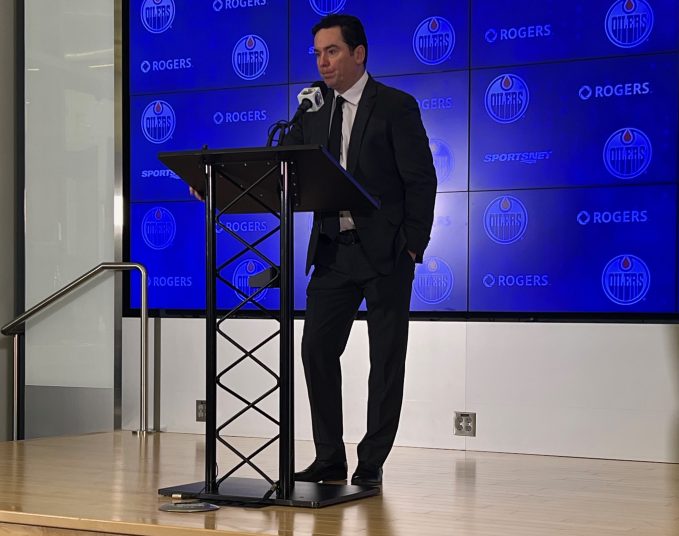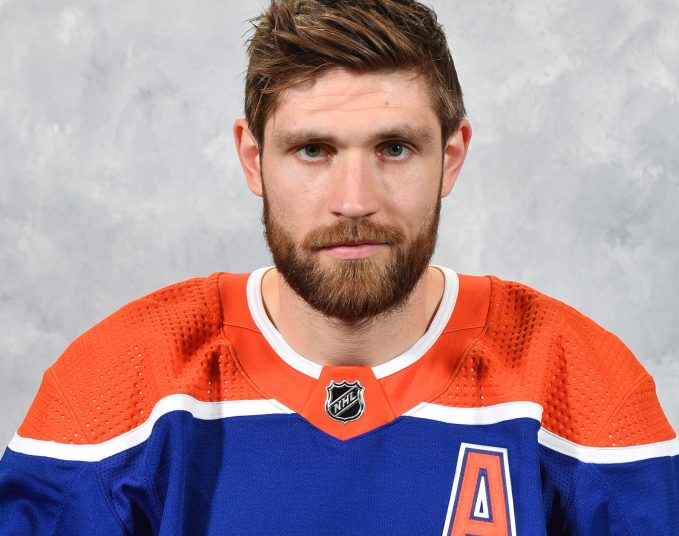If you’ve ever held hockey cards in your hand, you know that, no matter the year in which they’re issued, the layout is pretty much the same. There’s the photo of the hockey player, his name and the position he plays. In the position slot, there’s either a C, LW, RW, D or G.
But, when the ‘23-’24 sets come out, those Upper Deck and O-Pee-Chee cards won’t be entirely accurate. Because, when it comes to the Los Angeles Kings, the cards should read F, M, D.
The Kings, who will once again be the Oilers’ first-round playoff opponent, play a 1-3-1 system. When you look from up high, the Kings look like they are in a cross formation going up the ice. One forward leads, then three players line the middle of the ice. One defender trails behind.
Former Oilers coach Todd McLellan’s team goes up and down the ice kinda looking like a small flock of birds. During the Kings’ most recent visit to Rogers Place, a 2-0 win for the Oilers in late March, I had a few conversations with other press-box veterans about the system. Would it be fair to say that the Kings were defying the notion that hockey has to be played with three forwards and two d-men? The answers were… yes, yes, yes.
Really, it’s a forward, three mid-ice players (because the game is played on ice, I hesitate to use the term “midfielder”) and a trailing defenceman, set to guard against a turnover leading to a potential opposition breakaway.
The 1-3-1 isn’t new. It wasn’t invented by McLellan. But the Kings’ steadfast dedication to it is remarkable — and unusual. And they’ve gotten better at it over the last couple of seasons. That’s because hockey, unlike basketball or soccer, has been rather steadfast in its refusal to innovate. Since the rover was removed from the hockey rulebook about a century ago, it’s been defence, defence, wing, centre, wing. Most hockey attacking and defending systems run on the principles that those positions are absolute.
Compare that to soccer or basketball. It’s hard to keep track of all the different formations in soccer, and how systems evolve and then fall out of fashion. And, basketball has a variety of different offensive sets and defensive systems — and then, a little more than 10 years ago, Miami Heat coach Erik Spoelstra coined the term, “positionless basketball,” where players switch spots all over the court. Now, many NBA teams embrace that philosphy.
The thing is, why the 1-3-1 in hockey? Well, the three in the middle make it hard for the opposition team to navigate through the neutral zone. And, if the puck turns over, the Kings can come at you fast, and in numbers.
The Kings also preach high shot volume. It’s about playing the percentages; the more pucks you put on goal, the more chances you get a fluky one or can pounce on a fortuitous rebound.
“They shoot from everywhere, they’re one of those teams that are volume shooters,” Oilers coach Jay Woodcroft said of the Kings back in March.
The 1-3-1 usually means that if you try to attack down one side of the ice, the Kings’ leading forward and two of the mid-ice players come over to squeeze the puck carrier. They basically create an “overload” (stealing a soccer term here, because overloads are all the rage in soccer right now). Then, they turn the puck over and don’t worry too much about creating the perfect tic-tac-toe chance.
Of course, if the Kings were to find playoff success with this system, more teams will copy them. The thing is, while it might be interesting to see the Kings lay out this neutral zone overload, it does not lead to firewagon hockey. It’s why, when the Oilers managed to beat the Kings down the stretch, the scores were 2-0 in Edmonton and 3-1 in Los Angeles.
If the Kings are able to dictate tempo, don’t expect end-to-end hockey. The Oilers defeated the Kings in the first round of the previous playoffs; but, in the three games the Kings won, they were able to constrict the Oilers’ ability to blow through the middle of the ice and slow down the game.
A Kings-Oilers rematch has felt like it’s been on the cards for months. And it’s about two very different styles. Recent history has shown that the Oilers’ pace edges out the 1-3-1. But, a new battle is about to begin.
Savvy AF. Blunt AF. Edmonton AF.




